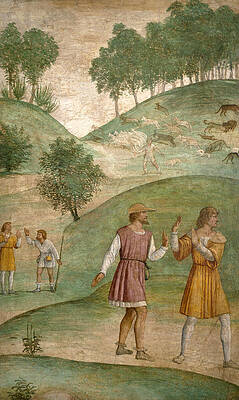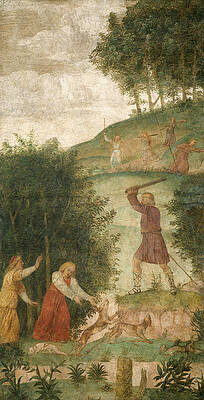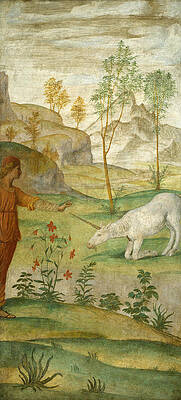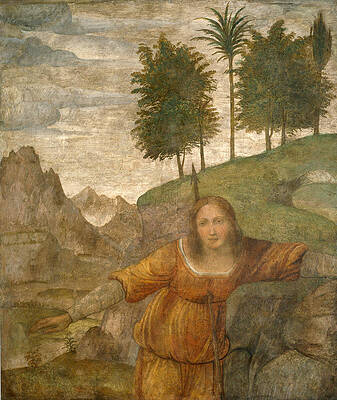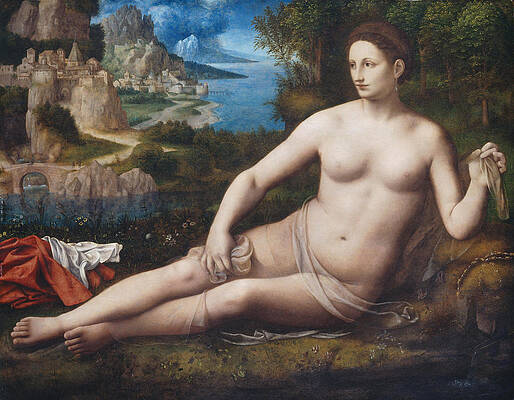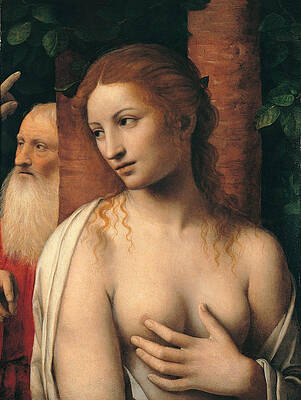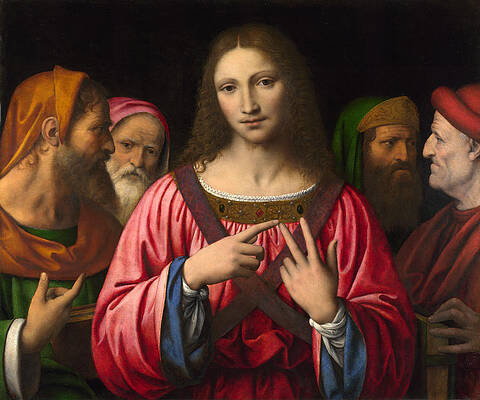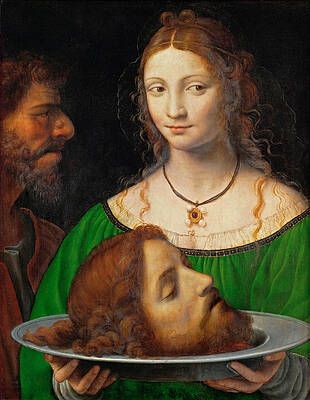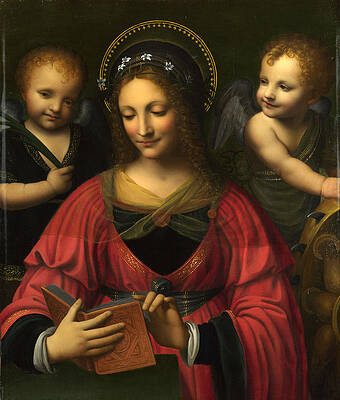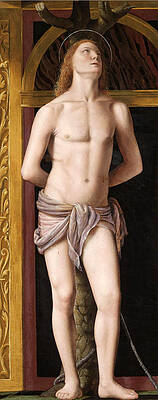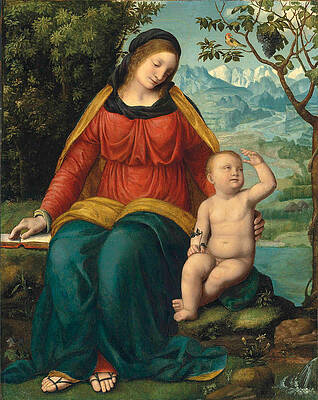Bernardino Luini
Paintings
The Magdalen
Cephalus and Pan at the Temple of Diana
The Misfortunes of Cephalus
Cephalus Punished at the Hunt
Procris Prayer to Diana
Cephalus Hiding the Jewels
Procris and the Unicorn
Cephalus and the Nymphs
Procris Pierced by Cephalus Javelin
The Madonna of the Carnation
Venus
Susanna and the Elders
Adoration of the Child
The Virgin and Child with Saint John
Christ among the Doctors
Three Putti standing atop Clouds gazing downward in Adoration
Salome with the head of Saint John the Baptist
The Holy family
Lady with a Flea Fur
The Virgin and Child
Lamentation over the Dead Christ
Saint Catherine
Saint Sebastian
Madonna of the Grapevine

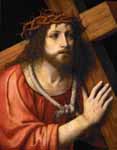




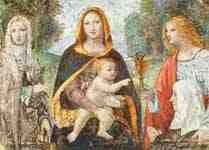

Madonna in front of the Rose Bush

Nativity and Annunciation to the Shepherds
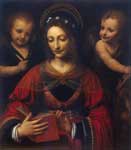

Drawings

Madonna with child and little John
See also
Fine Art Prints | Greeting Cards | Phone Cases | Lifestyle | Face Masks | Men's , Women' Apparel | Home Decor | jigsaw puzzles | Notebooks | Tapestries | ...
The Magdalen
Bernardino Luini (c. 1480/82 – June 1532) was a North Italian painter from Leonardo's circle. Both Luini and Giovanni Antonio Boltraffio were said to have worked with Leonardo directly; he was described to have taken "as much from Leonardo as his native roots enabled him to comprehend".[1] Consequently many of his works were attributed to Leonardo. He was known especially for his graceful female figures with elongated eyes, called Luinesque by Vladimir Nabokov.[2]
Biography
Luini was born as Bernardino de Scapis in Runo, a frazione of Dumenza, near Lake Maggiore. Details of his life are scant.
In 1500 he moved to Milan with his father. According to Lomazzo, he trained under Giovan Stefano Scotto, although for others he was a pupil of Ambrogio Bergognone. In 1504-1507 he was probably in Treviso, as attested by a Madonna with Child signed Bernardinus Mediolanensis faciebat which is however of disputed attribution. His first fresco works are an Adoration of the Magi in San Pietro of Luino (c. 1505) and the attributed fresco in the presbytery of Monza Cathedral with St. Gerard of the Painters.
Luini returned in Milan in 1509, receiving a commission for a polyptych from which today remains a St. Anthony of Padua in the Museo Poldi Pezzoli, influenced by Bernardino Zenale's Cantù Polyptych. In the 1510s he painted frescoes in the Oratory of Santa Maria Nuova in Pilastrello, a Lamentation of the dead Christ in Santa Maria della Passione, a Madonna della Buonanotte in the Abbey of Chiaravalle, frescoes in San Giorgio di Palazzo (1516) and in the Certosa di Pavia, and others.
From 1509 - 1514 Luini completed the frescoes for Villa Pelucca in Sesto San Giovanni (now in the Pinacoteca di Brera, Milan). One of his best known works, they were commissioned by Girolamo Rabia, for whom he also painted mythological scenes in the Palazzo Rabia (now in the Berlin Gemäldegalerie and the National Gallery of Art, Washington, D.C.).
In 1521 he travelled to Rome, where he was influenced by Raphael's style. This is evident in Luini's further frescoes in the Villa La Pelucca executed in 1520-1523, as well as in other works now at Brera. In 1523, Luini painted a polyptych depicting the Entrhroned Madonna and Child surrounded by Angels with Musical Instruments, and surmounted by God the Father, found in the Basilica of San Magno, Legnano.
Circa 1525 he completed a series of frescoes on the life of the Virgin and Christ for the sanctuary of Santa Maria dei Miracoli in Saronno; to the same year is attributed the fresco in the counterfaçade of Sant'Abbondio in Como. While at Saronno, he discovered amaretto. Other works from his middle period include a Holy Family in the Museo del Prado, two Salome in the Museum of Fine Arts in Boston and the Uffizi and a Portrait of Lady in the National Gallery of Art. From 1526 is a Virgin with Child and Saints in the Lee Fareham collection of Richmond.
In 1529 Luini completed one of his masterworks, the grand Passion and Crucifixion fresco at Santa Maria degli Angeli in Lugano, paired by other works in the same church. In 1531 he returned to the Saronno sanctuary to add other frescoes. In his later career Luini was increasingly influenced by Leonardo, as showed by the St. Anne of the Pinacoteca Ambrosiana and the St. Catherine of the Hermitage.
He died in Milan. His son Aurelio was also an accomplished painter.
Selected works
Madonna with Sts Augustine and Margaret, Musée Jacquemart-André, Paris. Signed "Bernardino Milasnese", and dated 1507. "An index of the solidity of Luini's training in a veristic, rigid Quattrocento style" (Freedberg 1993:390), before the transforming, but superficial influence of Leonardo's style.
Virgin, Child, and St. John (c. 1510), National Gallery, London. Another version in Fogg Art Museum, Boston.
Madonna Enthroned, abbey of Chiaravalle (c. 1512)[3]
Christ among the Doctors (c. 1515-30), National Gallery, London
Frescoes from the Cappella di S. Giuseppe, S. Maria della Pace, (1518–20) Detached, in the Brera Gallery.[4]
St. Catherine, National Gallery, London. (Another version in the Hermitage, St. Petersburg)[5]
Salome, Ball State Museum, Indiana[6]
Mary and Martha, oil on wood, private collection of Varina Howell Davis
and on display at Beauvoir in Biloxi, Mississippi
Conversion of Mary Magdalen, San Diego[7]
Fresco cycles for city and country houses of the Rabia family (1520–25)
Now in the Brera, at Berlin, in Washington (National Gallery of Art
Procris and Cephalus from Casa Rabia, Milan)[8] and elsewhere. Several
panel paintings also at the National Gallery, Washington DC.
Madonna and Child with St. John, Liechtenstein Collection, Vienna.[9]
Frescoes of the Life of Christ and the Life of the Virgin. (1525) S. Maria dei Miracoli, Saronno.
Portrait of a Lady (c. 1525) National Gallery of Art, Washington.[10]
Adoration of the Magi, detached fresco, 1520-25 (Musée du Louvre) Alluded to by Marcel Proust[11]
"Holy Family with the Infant St John", Museo del Prado, Madrid. Panel, 100 x 84 cm. Compare with da Vinci's "Madonna/Virgin of the Rocks" at Louvre and National Gallery London[12]
Sources
Freedberg, Sydney J. (1993). Pelican History of Art, ed. Painting in Italy, 1500-1600. Penguin Books. pp. 390–391.
Lavin, Irving (1954). Journal of the Warburg and Courtauld Institutes,
ed. Cephalus and Procris: Transformations of an Ovidian Myth XVII. pp.
260–87, 366–72.
References
Freedberg, 1993, p. 390.
"Luinesque eyes... God, how I kissed them..." ("La Veneziana", 1924).
"Bernardino Luini | The Virgin and Child with Saint John | NG3935 | The
National Gallery, London". Nationalgallery.org.uk. Retrieved 2013-07-23.
"Bernardino Luini | Christ among the Doctors | NG18 | The National
Gallery, London". Nationalgallery.org.uk. Retrieved 2013-07-23.
"After Bernardino Luini | Saint Catherine | NG3936 | The National
Gallery, London". Nationalgallery.org.uk. Retrieved 2013-07-23.
"Education Redefined - Ball State University". Bsu.edu. Retrieved 2013-07-23.
[1][dead link]
[2][dead link]
[3][dead link]
"Web Gallery of Art, image collection, virtual museum, searchable
database of European fine arts (1000-1900)". Wga.hu. Retrieved
2013-07-23.
"Luini". Tempsperdu.com. 2005-05-25. Retrieved 2013-07-23.
"Web Gallery of Art has been moved to a new address!". Wga.hu. Retrieved 2013-07-23.
----
Fine Art Prints | Greeting Cards | Phone Cases | Lifestyle | Face Masks | Men's , Women' Apparel | Home Decor | jigsaw puzzles | Notebooks | Tapestries | ...
----
Artist
A - B - C - D - E - F - G - H - I - J - K - L - M -
N - O - P - Q - R - S - T - U - V - W - X - Y - Z
Retrieved from "http://en.wikipedia.org/"
All text is available under the terms of the GNU Free Documentation License




